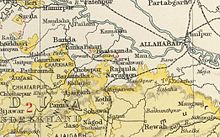| This article needs additional citations for verification. Please help improve this article by adding citations to reliable sources. Unsourced material may be challenged and removed. Find sources: "Chaube Jagirs" – news · newspapers · books · scholar · JSTOR (April 2017) (Learn how and when to remove this message) |
| Chaube Jagirs | |||||||
|---|---|---|---|---|---|---|---|
| Jagirs | |||||||
| 1812 (1812)–1948 (1948) | |||||||
 Flag
Flag | |||||||
 The area of the Chaube Jagirs in the Imperial Gazetteer of India | |||||||
| Area | |||||||
| • 1901 | 247 km (95 sq mi) | ||||||
| Population | |||||||
| • 1901 | 20,711 | ||||||
| • Type | British protectorate | ||||||
| History | |||||||
| • Established | 1812 (1812) | ||||||
| • Accession to the Indian Union | 1948 (1948) | ||||||
| • World War II | 1939-1945 | ||||||
| |||||||
| Today part of | India | ||||||
The Chaube Jagirs, also known as Kalinjar Chaubes, jagir states were a group of five feudal states of Central India during the period of the British Raj. They were a British protectorate from 1823 to 1947 and belonged to the Bagelkhand Agency. Their last rulers acceded to India in 1948.
History
| Gangaram Chaube | |
|---|---|
| Born | 17th century Bundelkhand, Uttar Pradesh, India |
| Died | 1685 (1686) Bundelkhand, Uttar Pradesh, India |
| Allegiance | Choubey |
Raja Chhatrasal of Panna State appointed Mandhata Chaube as the killedar of fort Kalinjar. His father Gangaram Chaube, a Jujhautiya Brahmin, commanded Chhatrasal when he raised the banner of revolt against the Mughals in Bundelkhand. Mandhata also repelled many Mughal attempts to occupy the fort. Kherandesh Khan, the faujdar of Itawa, attacked Kalinjar in 1701, but could not capture fort because of Mandhata's stiff resistance.
Later Chaube Brahmin officials rose from gentry to nobility. The owners of the first four estates were descendants of Ram Kishan, the former governor of Kalinjar under Raja Hirde Sah of Panna. Ram Kishan Chaube lost the siege of Kalinjar Ali Bahadur I died during the long siege. Later Chaubes occupied the fort and Ram Kishan declared Independence.
In 1862 the jagirdars were granted a sanad of adoption. The rule was that when no heirs were available an estate was split between the other members. The initial nine principalities by 1839 were reduced by two. In 1855 one estate was seized owing to the implication of the ruler in a murder case. In 1864 another principality was extinguished, leaving only five.
The Jagirdars were under the Bundelkhand Agency of the Central India Agency until 1896 when they were transferred to the Baghelkhand Agency. In 1931 they returned to the Bundelkhand Agency.
Chaube estates
The five surviving estates were:
Annexed by the British
Three states were confiscated by the British:
- Purwa with nine villages and an area of 53.18 km was annexed in 1855.
- Nayagaon with 18 villages and an area of 65.11 km was annexed in 1864.
See also
References
- Gupta, Bhagavānadāsa (1980). Life and Times of Maharaja Chhatrasal Bundela.
- Columbia-Lippincott Gazetteer p. 1414.
- Great Britain India Office. The Imperial Gazetteer of India. Oxford: Clarendon Press, 1908
- Imperial Gazetteer of India
| Former princely states in Central India | |
|---|---|
| Salute states | |
| Non-salute states |
|
| Jagir estates | |
| Extinguished (e)states | |
| Related topics | |
25°05′N 80°50′E / 25.083°N 80.833°E / 25.083; 80.833
Categories: